
Chords
Content
Harmonic vibrations in a stringFrequencies of modes and major scale
Harmonization of the major scale
Harmonization of the natural minor scale
Harmonization of the harmonic minor scale
Harmonization with sevenths
Harmonization in practice
Practice on an instrument
Chord Inversions
Creation of new chords
Adding notes to a chord
Alteration of notes to a chord
In the page Musical Notes we began our study of musical notes through of an experiment that allowed us to isolate the set of sounds that constitute the notes of the chromatic scale, base of Western music. Now, we mention that when the strings of the rudimentary instrument used in the experiment are plucked, like any real instrument, it does not produce pure sounds of a single frequency, but produces sounds that are a combination of sounds whose frequencies are multiples of the fundamental frequency given by the equation

where:
- f is the vibration frequency of the string.
- L is the length of the string.
- T is the tension applied to the string.
- µ is the density of the string material.
The following section will indicate how these additional frequencies are produced.
Harmonic vibrations in a string
Unless we release a string to its pulsations by giving it an initial shape that is exactly half sinusoidal, which is practically impossible during the execution of an instrument, the string will vibrate with a set, possibly infinite, of modes determined by its initial shape, all of them with forced nodes at the ends and other nodes separated by distances that are submultiples of the length of the string, as shown below:
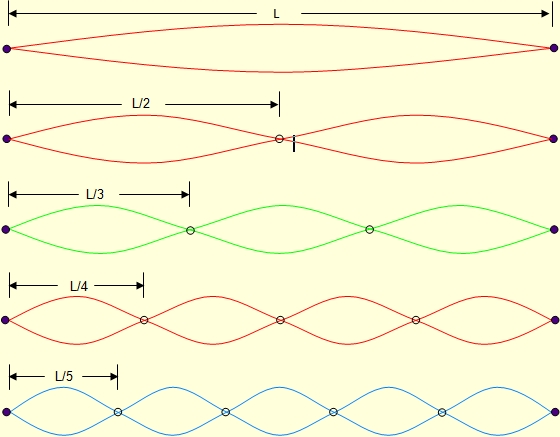
These string portions behave as if they were independent strings of shorter lengths L/n, so they will have frequencies given by:

We have limited the graph to only five modes of string vibration, enough to illustrate the theory that follows.
Frequencies of modes and major scale
Suppose that the length of the string is fixed in such a way that its fundamental frequency is that of note C4 (261.63), the same one with which we began our experiment in the Musical Notes page, then we will have:

Explanation. Remember that the theory considered in these pages aims to facilitate the learning of stringed and fretted instruments, in which the tempered scale is used. On the Musical Notes page, we calculate the frequencies of this scale, which we repeat below:

Now, the first thing we discovered in our experiment was that playing simultaneously the note C4(261.64Hz) and the note C5(523.25Hz) it was practically impossible to distinguish one from the other; this is one of the fundamental discoveries for the development of the theory of music and to which all the cultures of humanity have arrived. We have used this knowledge to reduce by successive divisions by two the frequencies of the harmonics generated by the string to the previous octave, and thus be able to identify their degree. The results that allowed the identification are the following: 784.88/2 = 392.44Hz (approximately G4) and 130813/4 = 325.93Hz (approximately E4), the small differences are due to the fact that the scale is tempered.
Harmonization of the major scale
The results of the previous section suggest that if we are respectful of the nature of things we should use degrees III and V to harmonize the first degree of the scale; we would thus be reinforcing the sound of modes 3 and 5, as the amplitudes of the modes generally decrease as their frequency increases. A chord made up of degrees I, III and V is called a major chord and is the most important in the harmonization of melodies in a major tonality, as they reaffirm it and establish a point of stability in its development.
Before proceeding to the harmonization of other degrees of the scale it is important that we consider the sequence of intervals contained in the C major chord that harmonizes the first degree of the C major scale: a third major interval (four semitones) between the grades I and III and a minor third interval (three semitones) between grades III and V. Therefore, to determine the chords that harmonize the rest of the degrees of the scale we simply take the note that corresponds to the grade we want to harmonize and starting with it we name three consecutive notes, the last one will be the second one of the chord; next, let's name another three consecutive notes starting with the latter, the third will be the third of the chord. For example: to harmonize the grade D of the second grade of the C scale we say: (D), E, (F) and then (F), G, (A); the chord is then constituted by the notes D, F and A. Note that it is the D minor chord of D, not the major chord of D. If we had used the same sequence of semitones that for the harmonization of the first degree we would have obtained the major chord of D, whose second note is F#, note that is outside the scale, and the harmonization would not have been diatonic; the desired harmonization is diatonic, that is, the one which is harmonized using only scale notes. The final result of this harmonization scheme is shown below.
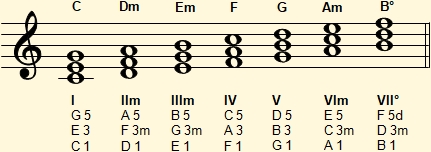
The specific names of the chords involved are displayed above the staff. The generic names of the chords are shown in bold below the staff.. These names start with the Roman numeral indicating the degree on which the chord is constructed, then, if the chord is not major, the mode is indicated, and finally the alterations of notes if any. Below the generic names of the chords is shown their composition, consisting of the name of the tonic note followed by the indication of the interval of the note to the tonic note of the chord and finally the alteration of this interval, if any. The indication of perfect has been omitted; so, 1 and 5 mean P1 and P5.
It is important to highlight the following facts for this result:
- The chords corresponding to degrees I, IV and V are majors. Remember that these degrees fulfill a tonal function; so these chords are the most important: they reaffirm the tone and together use all the notes of the scale:

- The chords corresponding to grades grades II, III and VI are minor.
- The resulting chord on the sixth degree of the scale, VIm, is the relative minor of the major chord on the first degree.
- The resulting chord on the seventh degree is a new type of chord within the context of these pages: a minor chord in which the internal fifth interval of the chord has been decreased.
A beautiful example of the application of the harmonization of the major scale is Pachelbel's D major canon. Below is a simple version of the first thirteen bars (the last one incomplete).
Relative chords in the harmonization of the major scale
Since the natural minor scale is built on the sixth degree of the major scale, the relative minor chord of a major chord is found nine semitones forward on the major scale, or what is equivalent: three semitones backward on this scale. The following arrangement of relative chords on this scale is thus available:

It will be useful to remember this detail when looking for the harmonization possibilities of a melody in a major tone.
Harmonization of the natural minor scale
The harmonization of the minor scales is carried out in the same way as that of the major scales. That is: to each note of the scale is added the note that is at a third interval and then is added the note that is at another third interval of this second note. The following figure shows the result of this process for the C natural minor scale; it is used in the same presentation scheme used to harmonize its major scale.

It should be noted that:
- The chords corresponding to grades I, IV and V are minor. As for the major scale, these degrees have a tonal function and are therefore the most important: they reaffirm the tonality and together use all the notes of the scale:
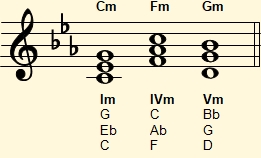
- The chords corresponding to degrees bIII, bVI and bVII are majors.
- The resulting chord on the third degree of the scale, bIII, is the relative major of the minor chord on the first degree.
- The resulting chord over the second is a minor chord in which the internal fifth interval of the chord has been decreased.
Relative chords in the harmonization of the smaller scale
Since the natural minor scale is built on the sixth degree of the major scale, the relative major chord of a minor chord is three semitones forward in the minor scale. The following arrangement of relative chords on this scale is thus available:

It will be useful to remember this detail when looking for the possibilities of harmonizing a minor tone melody.
Harmonization of the harmonic minor scale
In the page dedicated to the scales we indicate that the harmonic minor scale is obtained from the natural minor scale by raising a semitone the note corresponding to the seventh grade and we said that this change has its effects on harmonization, this is because all the degrees whose associated chords share this note with the chord built on the seventh degree of the natural minor scale this note will also see this note altered by one semitone upward. Below is the C harmonic minor scale; observe this scale uses the same key signature as the C natural minor scale, and that the fact that the B note is not flattened is indicated by the use of the natural accidental.
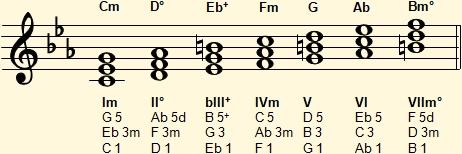
It should be noted that:
- The chord for the seventh degree goes from major to diminished minor.
- The chord for the fifth degree goes from minor to major.
- The resulting chord on the third degree is an augmented chord: there are eight semitones from Eb to B,an augmented fifth. In practice this chord is considered problematic and rarely used.
Just as the major scale harmonization and the minor scale harmonization introduce the diminished chord, the harmonization of the harmonic minor scale introduces a new type of chord: the major chord with augmented fifth. For the time being we will not explain the logic for the nomenclature of chords, but we will do so later.
Harmonization with seventh chords
In the previous sections we used triads to harmonize the different degrees of a scale. We can enrich the harmonization by adding an additional note to these triads, thus obtaining four-note chords. Using the logic used to form the triads, we will add to these triads the note that is a third interval above its last note.
Harmonization of major scales with seventh chords
The following figure shows the result of the harmonization of the C major scale with sevenths:
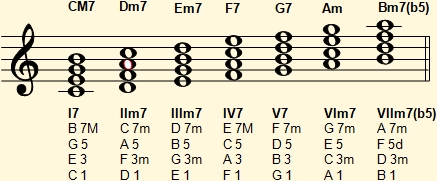
Note that there are four types of seventh chords:
- On degrees I and IV we obtain major seventh chords: to a major triad we add a note that forms a major seventh interval with the tonic (see the page dedicated to intervals).
- On degrees II, III and VI we obtain minor seventh chords: to a minor triad is added a note that forms a minor seventh interval with the tonic.
- Above grade V is a dominant seventh chord: to a major triad is added a note that forms a minor seventh interval with the tonic.
- A minor seventh chord with a diminished fifth is obtained on degree V: to a minor triad with a diminished fifth is added a note that forms a minor seventh interval with the tonic.
We will make extensive use of the dominant seventh chords throughout this site.
Harmonization of minor scales with seventh chords
The harmonization of minor scales by sevenths follows the same procedure used for major scales: we will add to their triads the note that is a third interval over its last note.
The following figure shows the result of adding sevenths to the C natural minor scale of C:
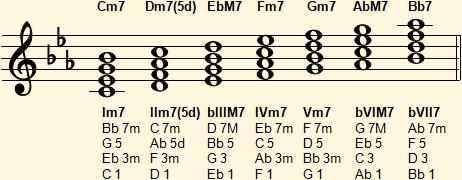
Note that you have the same four types of seventh chords as in the harmonization of the major scale, but with a different distribution.
Harmonization in practice
Our journey in the exploration of music theory has at times been somewhat arid, especially with regard to scales and chords, and perhaps you have wondered what the fruits of this effort will be and when they will be harvested. This is a point and time for the harvest.
Chord families
The above theory has prepared you to understand the rationality of the approach we propose to facilitate the search for chords to accompany a melody by means of an instrument: to elaborate tables in which you will record what is commonly referred to as the chord family for each key. You will begin these tables with the fundamental chords of the tonality, those built on grades I, IV, and V, and expand them as you progress through your studies.
To motivate you in the task of creating these tables we will consider the construction of a table for major tonalities. Suppose you are interested in playing a stringed instrument and have purchased a book for your learning. Normally these books begin the practical part by teaching the accompaniment of some simple melodies, and gradually introduce more and more complex melodies. An example of a very simple melody is "He's Got The Whole World In His Hands", which uses exclusively the chords corresponding to degrees I and V, which together form the nucleus of a tonality. We will now reproduce an arrangement of this melody in the C major key:
Suppose your book then teaches you to accompany the melody "Twinkle, Twinkle, Little Star" which uses chords corresponding to grades I, IV, and V, and is also in C major:
By learning to accompany this melody you will have achieved appreciable progress in your learning, since the chords corresponding to grades I, IV and V will allow you to accompany a large number of melodies. Finally, suppose that later in your book you find the accompaniment of "When The Saints Go Marching In", also in C major:
Note that this melody is accompanied basically by the same three chords used to accompany "Twinkle, Twinkle, Little Star", but introduces a new chord: the seventh chord built on the first degree: I7. However, in this melody the use of this chord is relatively fleeting, and only to prepare for the passage to the IV chord; in fact, it could be omitted.
Since at this point you have learned four chords and will later encounter many more, it is a good time for you to start your chord tables; one for each key. Here is the organization you could give to these tables, based on the three examples above for the C major key:
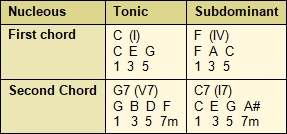
Practice on an instrument
If you play an instrument and have read this far to form an idea of the theory that supports its execution, it is time for you to use it to put into practice what you have learned. If you don't play any instrument and you don't have one, we advise you to buy a ukelele to start exercising what you've learned. The ukulele is a simple, low-cost and very portable instrument that has achieved great popularity in recent years, so we have chosen it as the first instrument for which we developed an introductory course. It has an enthusiastic community that organizes events in many parts of the world and has also placed on the internet an extensive collection of videos that will be very useful for your learning. In addition to the course contained in the pages dedicated to ukulele, the third tab of the menu of this site, MusicMate has developed the program UkuleleMate. This program will help you learn ukulele, and is described in more detail on the Software page, which describes the different programs developed by MusicMate to help you in your string instruments studies.
Next is the performance of "Oh Susanna", which uses the three fundamental chords of the C major tonality, in UkuleleMate:
Chord Inversions
The order in which the notes are typed in the chords used in the previous interpretation is:
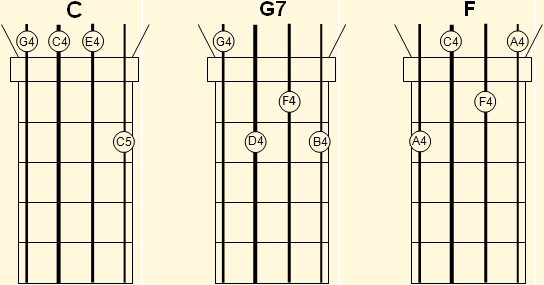
If we order the notes of these chords from lower to higher we will have:

We see that only in the C chord the tonic is the lowest of the notes, for chords G7 and F the lowest note is the one that is at a fifth interval with respect to the tonic.
- For a chord whose lowest note is the tonic it is said to be in fundamental position.
- For a chord whose lowest note is the third, it is said to be in first inversion.
- For a chord whose lowest note is the fifth, it is said to be in second inversion.
- For a chord whose lowest note is the seventh, it is said to be in third inversion.
Therefore in this interpretation of "Oh Susanna" in the ukulele we have the C chord in fundamental position, and the G7 and F chords in second inversion.
In this case the use of inversions was derived from the desire to use "open" positions, that is, to use air strings, which greatly facilitates fingering. When we study the solo interpretation of a frettered instrument we will see that there are other reasons to use inversions of chords; for example, to make the chords include the notes of the melody, in the same octave in which they are found.
Creation of new chords
Something that can be extremely confusing and intimidating for those who begin studying a fretted instrument is the enormous amount of existing chords: there are books with collections of thousands of chords. One of the reasons why we undertook the study of harmonization of scales was to show, within this vastness, which are, and where they come from, the most important chords; however, there are still many other chords that are in common use and that we do not consider some of them in our study. In this section we will consider some of them. There are two basic mechanisms we use to create the chords studied so far: add notes to the triads and alter some of their notes, always taking care that our harmonization was diatonic; that is, with notes corresponding to the scale. These are the same mechanisms we will use to obtain additional chords, but the explanations in this section will not be as formal or detailed. We will not worry about the dissonant nature of the chords we obtain; many of them will be, but it will be up to you to decide which of them you will incorporate into your harmonizations.
Adding notes to a chord
Adding notes to the triads
The following diagram shows different notes that can be added to the fundamental triads to generate four-note chords. Note that due to the limitations imposed by the number of strings of the instruments we will study and the reentrant tuning of some of them, the notes corresponding to degrees IX through XIII are transported to the base octave.

The numbers appearing below the scale are those used for the naming of the chords resulting from the addition of one of these notes to the triads. This process is described below for each case. To contrast with the above approach and set ideas we will start with the seventh chords, which we already know.
Seventh chords
The following figure shows the process of generating this type of chords. Note that they are identified by adding to the identifier T of the major triad the digit 7: C7, C#7, D7, etc.
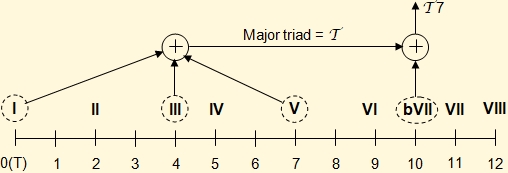
If you add to a minor triad the note that is at a minor seventh, degree bVII of the minor natural scale, you get a minor seventh chord. Note that they are identified by adding to the T m identifier of the minor triad the digit 7: Cm7, C#m7, Dm7, etc.
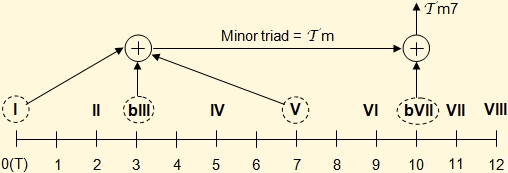
The other two seventh chords we know, major seventh chords and minor seventh chords with diminished fifth, are obtained by alteration of notes from these two seventh chords, as we will see later.
Sixth chords
In a similar way to the one used to generate the seventh chords, it is possible to generate the so-called sixth chords by adding the note corresponding to the sixth degree of the scale to the major and minor triads. For major triads:
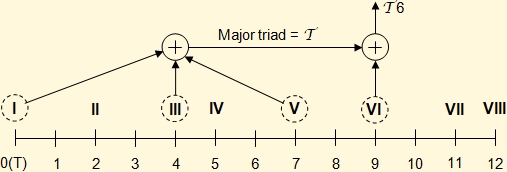
Thus there are the chords C6, C # 6, D6, etc., which are named as C sixth, C sustained sixth, D sixth, etc. For minor triads:
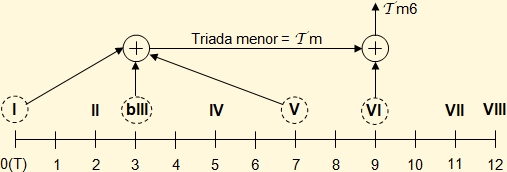
Thus we have the chords Cm6, C-m6, Dm6, etc., which are named as C minor sixth, C sharp slower sixth, D minor sixth, etc.
Chords with ninth, eleventh or thirteen added
At this point in our chord studies we have considered the use of almost all the notes of an octave of major scales and minor scales to form chords; the notes corresponding to the second degree of these scales have yet to be used. In instruments such as the piano this is done with the addition of the note corresponding to the ninth degree, octave of the second degree; but due to the limitations imposed on fingering by the number of strings of the instruments we will study and the reentrant tuning of some of them, the notes corresponding to the second degree are normally used directly.
The following diagram illustrates the formation of chords not only of added ninth but also of chords with added eleventh and added thirteenth.

Thus the are the chords Cadd9, Cmadd9, C#add9,...,Cadd11, Cmadd11, C#add11,...,Badd13, Bmadd13, named C with added ninth, C minor with added ninth, C sharp with added ninth, ..., C with added eleventh, C minor with added eleventh, C sustained with added eleventh, ..., B with added thirteenth, B minor with added thirteenth.
Adding notes to seventh chords
The process of adding notes can be applied repeatedly, so it is possible to generate other types of chords by adding notes to the seventh chords. The following figure summarizes the main extensions added to a seventh chord (major or minor):

Note that the nomenclature used for these chords is simpler than that used for the chords in the previous section: the name of the expanded chord is formed by the name of the base chord (without extension 7, which is understood) and the digit that identifies the degree of the added note. The chords C9, Cm9, C#9,...,C11, C11, C#11,...,,B13, B13, which are named as C ninth, C minor ninth, C sharp ninth, ..., C eleventh, C minor eleventh, C sharp eleventh, ..., B thirteenth, B minor thirteenth.
In addition to the limitation imposed by its reentrant tuning to the octave in which the added notes can be fingered, the ukulele and the cuatro, to be studied in this site, have an additional limitation: they only have four strings; therefore in them these chords cannot be fingered in complete form, since they are constituted of five notes. It is necessary to approximate these chords by using only four notes.
Altering the notes of a chord
We pointed out before that the basic mechanisms for creating new chords are two: the addition of notes to a chord, which we have just studied in the previous sections, and the alteration of the notes of a chord. The following figure illustrates the most common alterations:

Alteration of the note corresponding to the third degree
If you decrease the note corresponding to the third degree of a minor chord in a semitone you get a suspended second chord, which is identified in this work as Tsus2, where T is the letter that identifies the tonic. The chord Csus2, C#sus2, Dsus2, etc. are named as C suspended 2, C sharp suspended 2, D suspended 2, etc.
If you increase by one semitone the note corresponding to the third degree of a major chord, you get a suspended fourth chord, which is identified in this work as Tsus4, where T is the letter that identifies the tonic. The chords Csus4, C#sus4, Dsus4, etc., are named C suspended fourth, C sharp suspended fourth, D suspended fourth, and so on.
Alteration of the note corresponding to the fifth grade
Diminished fifth
If you decrease the note corresponding to the fifth degree of a major or minor chord in a semitone, you get a diminished fifth chord, which is identified in this work as T(m)5- in the text areas or as T(m)5- in the graphs. In the literature they are also represented as T(m)b5. The chords C5-, Cm5-, C#5-, etc. are named C with diminished fifth, C minor with diminished fifth, C sharp with diminished fifth, etc.
Augmented fifth
Increasing by one semitone the note corresponding to the fifth degree of a major or minor chord results in an augmented fifth chord, which is identified in this work as T(m)5+ in the text areas or as T(m)5+ in the graphs. In the literature they are also represented as T(m)#5. The chords C5+, Cm5+, C#5+, etc. are named C with augmented fifth, C minor with augmented fifth, C sharp with augmented fifth, etc.
Alteration of the note corresponding to seventh grade
If you increase in a semitone the note corresponding to the bVII degree of a chord is the seventh dominant in a halftone, a major seventh chord is obtained, which is identified in this work as T(m)M7. Thus you have the chords CM7, CmM7, C-M7, etc., wich are named as C major with major seventh, C minor with major seventh, C sharp major with major seventh, etc.
Diminished chords
It is possible to apply more than one alteration to a chord. For example, let's take a minor dominant seventh chord, which as we know is made up of notes corresponding to degrees I, bIII, V, and bVII, and let's decrease the notes corresponding to degrees V and bVII by one semitone. We will then have a diminished chord, which is identified in this work as T°. The chord C°, C#°, D°, etc., are named C diminished, C sharp diminished, D diminished, etc.
Diminished chords have a symmetry that makes them verye interesting and useful. Consider for example the representation of the chord C° in the analogy of the clock:
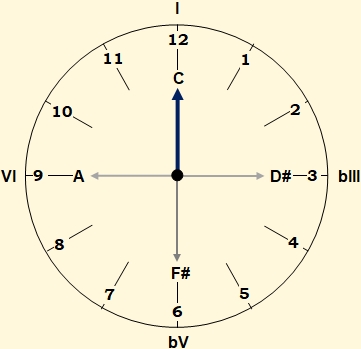
In this figure the black hand points towards the tonic of the chord. It is obvious that if one advances 3 hours (90°) the set of hands that point out the constitutive notes of the chord will point to a chord constituted by the same notes, but whose tonic is now D#; that is, the chord D#°. If these turns are continued, the chords F#° and A° will be obtained successively; therefore, the equivalent set of chords (C°, D#°, F#°, A°) has been completed. From this result it can be inferred that the set of notes corresponding to a diminished chord represents any of the diminished chords of tonalities separated by three semitones. Another interesting aspect of this distribution of notes is that if from the position shown two turns of the set of hands of 1 hour each are made, the sets of equivalent chords (C#°, E°, G°, A#°) and (D°, F°, G#°, B°) will be obtained successively; it is thus concluded that three turns of one hour are enough to obtain the diminished chords for all tonalities.
The properties of the diminished chords make them extremely useful for effects of re-harmonization of melodies, aspect that we will consider in the accompaniment by means of instruments.
Various